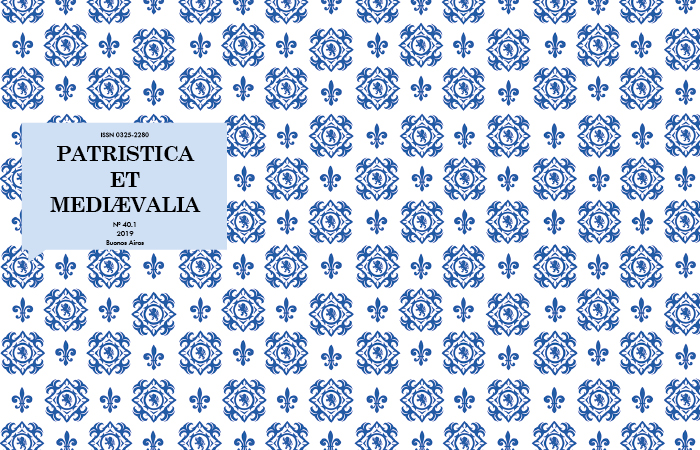Meditation According to Anselm of Canterbury
Resumen
The meditatio theme sends us directly to the spiritual framework of the monasteries where St. Anselm of Canterbury is one of the most relevant representatives in the High Middle Ages. As a Benedictine monk, Anselm acknowledges and lives fully the return to the self as introspection: recollecting oneself, in silence, in search of God. Distancing oneself from the world (a type of contemptus mundi) and love for God’s kingdom constitute the most indicative signs of happiness that may be enjoyed by a monk in the 11th century. One of the first aspects of meditation is the insertion within the conquest of the inner self as a self-acknowledgement of the soul to seek God assumed by faith. Current essay will discuss meditation within the context of monastic spirituality in Anselm’s time and the model of meditative prayer as elabo- rated in (1) the Proslogion, a treatise known to be a meditation on the reason of faith and (2) the Third Meditation, dealing with the redemption of the human stance. It will be demonstrated that meditation and contemplation, according to Anselm, have their full meaning within the salvation mysteries.Descargas
Citas
Antoni, G. (1997). La prière chez Saint Augustin. D’une philosophie du langage à la théologie du verbe. París: Vrin.
Bestul, T. H. (1983). “St Anselm, the Monastic Community at Canterbury, and Devotional Writing in Late Anglo-Saxon England”. En: Evans, G. R. (ed.). Anselm Studies: An occasional Journal (vol. 1). Nueva York: Kraus International Publications, 185-198.
Briancesco, E. (1981). “Sentido y vigencia de la cristología de San Anselmo: ensayo de lectura estructural del ‘Cur Deus homo’. 1ra parte”, Stromata 37.1/2, 3-18.
Briancesco, E. (1982). “Sentido y vigencia de la cristología de San Anselmo: ensayo de lectura estructural del ‘Cur Deus homo’. 2da parte”, Stromata 38.3/4, 283-315.
Briancesco, E. (1984). “Le portrait du Christ dans le Cur Deus homo. Herméneutique et démythologisation”. En: Foreville, R. (dir.). Les mutations socio-culturelles au tournant des 11e - 12e siècles. París: CNRS, 631-646. (Spicilegium Beccense II).
Carpin, A. (2000). La redenzione in Origine, S. Anselmo e S. Tommaso. Bolonia: Studio domenicano.
Chenu, M.-D. (19863). La théologie au XIIe siècle. París: Vrin.
Congar, Y. (1974). “Modèle monastique et modèle sacerdotal en Occident de Gregoire VII (1073-1085) à Innocent III (1198). En: Idem (ed.). Études de civilisation médiévale (IXe - XIIe siècles). Mélanges offerts à E.R. Labande. Poitiers: SESCM, 153-160.
Corbin, M. (1992). Prière et raison de la foi. Introduction à l’œuvre de s. Anselme de Cantorbéry. París: Cerf.
Ghisalberti, A. (1988). “Dilecto dilectus, amico amicus, fratri frater: l’epistolario beccense di Anselmo d’Aosta”, La Scuola cattolica 116, 339-355.
Gilson, E. (1930). La théologie mystique de S. Bernard. París: Vrin.
Leclercq, D. J. (1990). L’amour des lettres et le désir de Dieu. Initiation aux auteurs monastiques du Moyen Âge. París: Cerf.
Roques, R. (1970). “Structure et caractères de la prière anselmienne”. En: Ko-hlenberger, H. K. (ed.). Sola Ratione (Anselm-Studien für Pater Fr. S. Schmitt OSB). Stuttgart - Bad Cannstatt: Friedrich Frommann, 119-187.
Schmitt, F. S. (1955). “La Meditatio redemptionis humanae di S. Anselmo in relazione al Cur Deus homo”, Benedictina 9, 197-213.
Southern, R. W. (1990). Saint Anselm. A Portrait in a Landscape. Cambridge: Cambridge University Press.
Southern, R. W. (1966). Saint Anselm and his Biographer. A Study of Monastic Life and Thought: 1059-1130. Cambridge: Cambridge University Press.
Ward, B. (1973A). Anselm of Canterbury: A Monastic Scholar. Oxford: SLG Press (Fairacres publications 62).
Ward, B. (1973B). “The Place of St. Anselm in the Development of Christian Prayer”, Cistercian studies 8.1, 72-81. Wilmart, A. (1932). Auteurs spirituels et textes dévots du Moyen Âge latin. Étudesd’histoire littéraire. París: Bloud et Gay.
1. Los/as autores/as que publiquen en esta revista aceptan las siguientes condiciones:
-
Conservan los derechos de autor/a y ceden a la revista el derecho de la primera publicación, con el trabajo registrado con Licencia Atribución-CompartirIgual 4.0 Internacional, que permite a terceros utilizar lo publicado siempre que mencionen la autoría del trabajo y a la primera publicación en esta revista.
-
Pueden realizar otros acuerdos contractuales independientes y adicionales para la distribución no exclusiva de la versión del artículo publicado en esta revista (p. ej., incluirlo en un repositorio institucional o publicarlo en un libro) siempre que indiquen claramente que el trabajo se publicó por primera vez en esta revista.
-
Tienen permitido y se les recomienda publicar su trabajo en Internet (por ejemplo en páginas institucionales o personales).
2. Condiciones de auto-archivo. Se permite y se anima a los/as autores/as a difundir electrónicas la versión post-print de sus obras ya que favorece su circulación y difusión y con ello un posible aumento en su citación y alcance entre la comunidad académica. Color RoMEO: azul.













